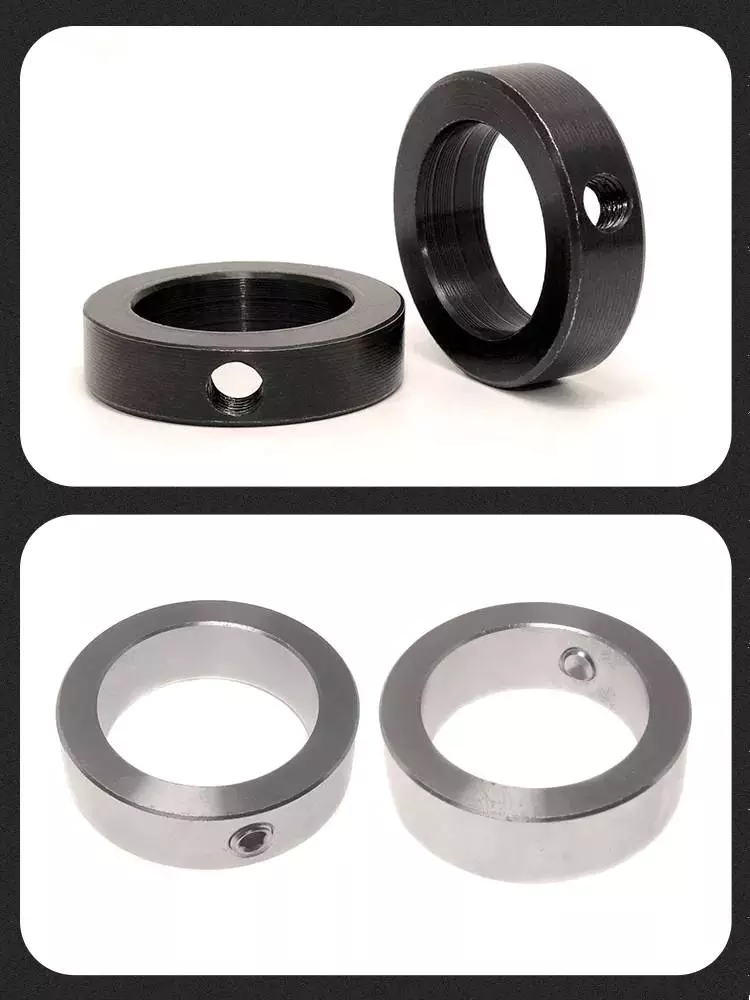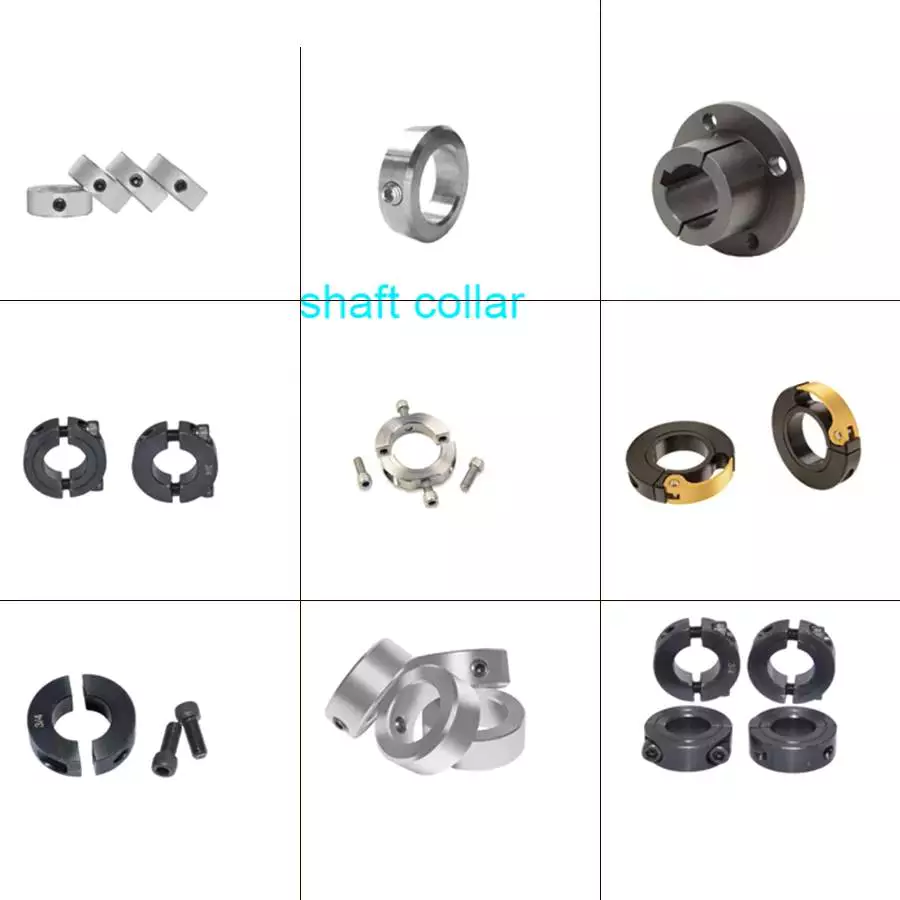Product Description
Secure items to either side of these collars-each half has a flat end with a tapped hole. The two-piece design allows you to install them anywhere on a shaft without removing components or having access to the ends of the shaft. Tighten or loosen with the clamping screws. The 2 halves press evenly around the outside of shafts, so they hold tight without causing damage.
Electroless Nickel Plating steel collars have some corrosion resistance. Aluminum collars are lightweight with good corrosion resistance. 1045 carbon steel collars have excellent corrosion resistance.
| Standard: | GB |
|---|---|
| Material: | Carbon Steel |
| Connection: | Side Mount, Split |
| Surface Treatment: | Electroless Nickel Plating |
| Head Type: | Round |
| Tightening Method: | Two Piece Clamp-on |
| Samples: |
US$ 4.5/Piece
1 Piece(Min.Order) | |
|---|
| Customization: |
Available
| Customized Request |
|---|

What are the temperature and corrosion resistance properties of shaft collars?
The temperature and corrosion resistance properties of shaft collars vary depending on the materials they are made of. Different materials exhibit different levels of resistance to temperature extremes and corrosion. Here are some commonly used materials for shaft collars and their temperature and corrosion resistance properties:
- Steel: Steel shaft collars, particularly those made from stainless steel, offer excellent temperature and corrosion resistance properties. Stainless steel is known for its high strength, durability, and resistance to rust and corrosion. It can withstand a wide range of temperatures, from low cryogenic temperatures to high heat environments. Stainless steel shaft collars are often used in applications where exposure to moisture, chemicals, or harsh environments is a concern.
- Aluminum: Aluminum shaft collars have good temperature resistance properties and can handle moderate temperature ranges. They are lightweight and offer reasonable corrosion resistance. However, aluminum is not as corrosion-resistant as stainless steel and may be susceptible to certain chemicals or highly corrosive environments. Aluminum shaft collars are commonly used in applications where weight reduction is a priority, such as aerospace or automotive industries.
- Plastic: Plastic shaft collars, such as those made from nylon or acetal, have limited temperature resistance compared to steel or aluminum. They can typically handle moderate temperatures but may deform or degrade at higher temperatures. Plastic collars are not as resistant to corrosion as metal collars but can still offer good resistance to certain chemicals and environmental conditions. Plastic collars are often used in applications where weight, cost, or electrical insulation properties are important factors.
- Brass: Brass shaft collars offer good temperature resistance and moderate corrosion resistance. They can handle a range of temperatures and are often used in applications where a combination of durability, conductivity, and aesthetics is required. Brass collars may tarnish over time but can still maintain their functionality and structural integrity.
It is important to note that the temperature and corrosion resistance properties of shaft collars can also be influenced by factors such as the specific alloy composition, surface treatments, and environmental conditions they are exposed to. When selecting shaft collars for your application, it is crucial to consider the temperature range and potential exposure to corrosive substances or environments. Consulting with manufacturers, reviewing technical specifications, and considering industry standards or guidelines can help ensure that you choose shaft collars with appropriate temperature and corrosion resistance properties for your specific needs.

What are the advantages of using two-piece vs. one-piece shaft collars?
When considering shaft collars, you may come across two main types: two-piece and one-piece shaft collars. Each type has its advantages depending on the specific application and requirements. Here are the advantages of using two-piece and one-piece shaft collars:
Advantages of Two-Piece Shaft Collars:
- Easy Installation and Removal: Two-piece shaft collars are designed to be split into two halves, allowing for easy installation or removal on a shaft without the need to disassemble other components or move the shaft. This can save time and effort during installation or maintenance procedures.
- Positioning Flexibility: Two-piece collars often have a clamping mechanism that allows for fine adjustment and precise positioning along the shaft. This can be advantageous when precise placement is required, such as aligning components or achieving specific clearance or spacing.
- Accessibility for Retrofitting: In situations where it may be difficult or impractical to slide a collar onto the end of a shaft, two-piece collars provide a convenient retrofitting solution. They can be installed around the shaft by opening the collar and clamping it in place, making them suitable for retrofitting on existing shafts or equipment without requiring shaft disassembly.
- Shaft Protection: Two-piece collars typically have a split design with smooth, rounded edges, which helps prevent damage to the shaft during installation or removal. The collar halves can distribute clamping forces evenly, reducing the risk of shaft deformation or scoring.
- Collar Customization: Two-piece collars often offer more customization options, such as the ability to replace or interchange collar components, add features like mounting holes or attachment points, or modify the collar to accommodate specific shaft sizes or configurations.
Advantages of One-Piece Shaft Collars:
- Simplicity and Compactness: One-piece shaft collars have a simple, solid construction without any moving parts or additional components. This makes them compact and easy to handle, and they require less space along the shaft compared to two-piece collars.
- Cost-Effectiveness: One-piece collars are often more cost-effective than two-piece collars due to their simpler design and manufacturing process. They can be a budget-friendly option for applications where precise positioning or frequent adjustments are not required.
- High Clamping Force: One-piece collars can provide high clamping force due to their solid construction and uniform distribution of pressure. This makes them suitable for applications where a secure and rigid connection between the collar and the shaft is crucial.
- Low Maintenance: Since one-piece collars do not have moving or adjustable parts, they typically require less maintenance. Once installed, they provide a reliable and stable connection without the need for periodic adjustments or repositioning.
- Compatibility with High-Speed Applications: One-piece collars are generally well-suited for high-speed applications due to their solid construction and balanced design, which can minimize the risk of imbalance or vibration at high rotational speeds.
Ultimately, the choice between two-piece and one-piece shaft collars depends on factors such as the specific application requirements, ease of installation or retrofitting, customization needs, cost considerations, and desired level of adjustability or precision. It is important to evaluate these factors and select the type of shaft collar that best suits your needs for optimal performance and functionality.

Can I find reviews on popular brands of shaft collars for user feedback?
Yes, it is possible to find reviews on popular brands of shaft collars to gain user feedback and insights. Here are some sources where you can look for reviews:
- Online Retailers: Online retailers such as Amazon, eBay, and industrial supply websites often feature customer reviews and ratings for products, including shaft collars. You can visit the product pages of specific brands or models of shaft collars and read user reviews to get an idea of their performance, quality, and user satisfaction. These reviews are typically provided by customers who have purchased and used the products, offering valuable feedback based on their experiences.
- Industrial Forums and Communities: Online industrial forums, discussion boards, or communities dedicated to mechanical components and equipment can be a valuable resource for finding user feedback on different brands of shaft collars. Participating in these communities and posting specific inquiries about certain brands or models can help you connect with industry professionals, engineers, or users who have firsthand experience with specific shaft collar brands. They can provide insights, recommendations, and share their opinions or experiences to assist you in making an informed decision.
- Manufacturer Websites: Some manufacturers maintain customer review sections or testimonials on their websites. Visiting the websites of popular shaft collar brands and exploring their product pages or customer support sections may provide access to reviews or feedback from users who have used their specific products. Manufacturer websites often include case studies, application examples, or testimonials that can give you an idea of the performance and user satisfaction associated with their shaft collars.
- Professional Publications and Magazines: Professional publications, trade magazines, or industry-specific journals related to mechanical engineering, industrial equipment, or power transmission may feature product reviews or evaluations. These publications often conduct independent tests, assessments, or interviews with professionals in the field to provide objective insights and feedback on various products, including shaft collars. Checking these publications or their online platforms can give you access to expert opinions and evaluations.
- Social Media and Online Groups: Social media platforms like LinkedIn or Facebook may have industry-specific groups or communities where professionals and enthusiasts discuss mechanical components and equipment. Joining these groups and engaging in conversations can help you connect with individuals who can provide feedback or recommendations based on their experiences with different brands of shaft collars.
When reading reviews, it's important to consider multiple sources and evaluate the overall consensus rather than relying solely on individual opinions. Look for patterns, common experiences, and consider the credibility of the sources providing the reviews. Keep in mind that user feedback can vary, and personal preferences or specific application requirements may influence opinions. By gathering insights from various sources, you can make a more informed decision about the popular brands of shaft collars and their suitability for your specific needs.


editor by CX 2023-11-16